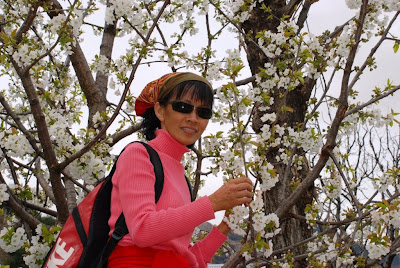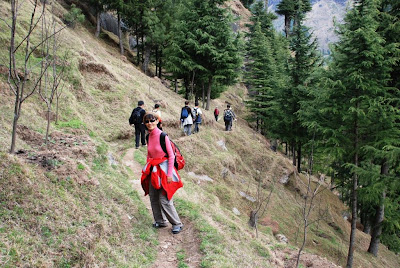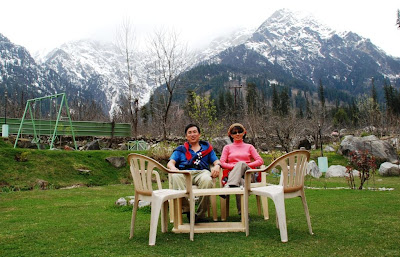.JPG)
I love trekking and one of the best trails I ever trekked is Tiger Leaping Gorge (Hutiao Xia) in Yunnan China. Tiger Leaping Gorge (TLG) is about 80 Km northwest of Lijiang and is the deepest gorge in the world. This 15 Km long gorge lies between Jade Dragon Snow Mountain (Yulong Xueshan) and Haba Snow Mountain (Haba Xueshan). Peak of Jade Dragon Mountain is about 5,600 meters and Peak of Haba Mountain is 5,400 meters. At the bottom of the gorge is the Golden Sand River (Jingsha Jiang) which becomes the mighty Yangtze River down
.JPG)
steam. The narrowest portion of the gorge is only 30 meters wide with a stone in the middle of the river. Legend says that a tiger jumped across the river at this narrowest point to escape from a hunter and hence the name of this gorge. The inhabitants in this area are mainly the Nazi ethnic minority. The total length of TLG trail is about 40 Km long which starts from Qiaotao and ends at Daju. The trail can be covered in 2 days but we opted for a 3 days leisure trek. There are a few guesthouses along the trail. The best time to trek TLG is autumn or spring. Summer is peak season and may be crowded. We did it in late autumn of 2006.
.JPG) Jade Dragon Snow mountainDay 1
Jade Dragon Snow mountainDay 1
We left Shangri-La in the late morning and arrived at Qiaotao around noon. We had lunch at a nearby restaurant while our guide was busy negotiating with the locals for mules transport. Our team of 16 members includes tour leader and a local guide. After lunch we proceed to our starting point which is just a short distance from the gorge entrance. The local farmers with their mules were there waiting for us. 3 mules were used to carry luggage and 9 of us including me and my wife opted for the mule ride. The fee for mule ride is only RMB100 per day and we hire the service for 2 days. I have never ridden a horse or mule before and this is really a good experience for me especially when negotiating narrow winding tracks. Day 1 trek was easy, relatively flat with some slight ascent and took us about 2 hours to reach our first destination, Nazi Guesthouse. The weather is superb, cool with bright sunny sky. The trail was scenic all the way and the view was spectacular, with the majestic Jade Dragon Mountain on the other side of the gorge. We passed thru some farms and villages. The locals here are friendly and some waved their hands as we pass thru. We arrived at Nazi Guesthouse around 3.00 pm. Nazi Guesthouse is a typical Nazi family house with a courtyard surrounded by 4 blocks of buildings. The guest rooms are on the top floors and each with a window to a beautiful view. The amenities are very basic, no heater, no hot shower, 2 common bathrooms to share, one gents’ toilet and one ladies’ toilet. I quickly took a shower while the sun is still up. We took the whole afternoon exploring the guesthouse and nearby village. Our dinner at 7.00 pm was served on a long table. It was a simple Nazi dinner food and it tastes good. The temperature starts to dip when the sun sets and I have to put on my wind breaker. We gathered at the courtyard after dinner accompanied by 2 young friendly Nazi girls. These are the same 2 girls who make our rooms and prepared our meals. Tonight, they teach us how to do the Nazi dance. We had a wonderful time till late night.
.JPG) Nazi Family House
Nazi Family House.JPG) Doing the Nazi danceDay 2
Doing the Nazi danceDay 2Morning was broken by the call of roosters. I looked out my window and saw the most memorable view. The silhouette of the jagged peaks of Jade Dragon Mountain and the slow swaying trees under the crescent moon light was simply unforgettable. I watched and admired at this tranquil scene for almost half an hour.
We had simple Nazi pancake with coffee for breakfast. The Tibetan Yak butter tea is also available but it’s not agreeable with my taste bud. Day 2 trek is expected to be tough as we have to ascent 900 meters thru what the locals referred to as the ’28 bends’. We left Nazi Guesthouse at 9.00 am and were soon struggling up the ’28 bends’. More spectacular sceneries as we ascent higher. The snow jagged peaks of Jade Dragon Mountain with drifting misty clouds and the gushing Jingsha River below remind me of those ancient Chinese watercolors. The romantic colors of autumn are everywhere. Patches of green, yellow, brown and red vividly displayed on the slope of the mountain. Our shaded trail is paved with fallen colored leaves. We made a couple of stops on the way and many were busy with their cameras shooting the spectacular views. We arrived at our 2nd destination, Tea Horse Trade Guesthouse, around 1.00 pm. Our mule ride service end here and we bid farewell to their owners. Only 3 mules are left behind for the luggage. We had a late lunch and immediately after lunch everyone armed with their cameras again and starts exploring the neighborhood. There was a small waterfall nearby but the water was too cold for me to take a bath. The neighbors are really friendly and some even invite us to their house. Later in the evening a few of us gath
.JPG)
ered at a resting area just beside our guesthouse for a couple of beers. From the rest area we have a good view of Jade Dragon Mountain to the East. When the evening sun sets, Jade Dragon Mountain glows like a gigantic piece of gold in front of us. The shadow cast on the mountain then starts to inch slowly upwards till its tip and then disappeared into the darkness of the night. Dinner was at 7.30 pm and to night we had 2 more trekkers joining us. Both are female and if I remember correctly, they are from down south Australia.
Tea Horse Trade Guesthouse.JPG) Silhouette of Jade Dragon MountainDay 3
Silhouette of Jade Dragon MountainDay 3After a good night sleep, we woke up early at 6.00 am to catch the sunrise. The sunrise is not as spectacular as the sunset but we still enjoy the cool fresh morning breeze. After a simple breakfast we move on again. Day 3’s trek is equally tough and much longer than Day 2. The first part of the trek in the morning is relatively flat with a short steep descent to the service road where Tina’s Guesthouse is situated. As usual the trail is scenic and we pass thru villages and some nice waterfalls. We arrived at Tina’s Guesthouse at 1.00 pm and had our lunch here. Our mule service for luggage ends here. From Tina’s Guesthouse we took a short van ride, about10 Km down the road where we continue our trek to Daju. The most difficult part of today’s trek starts from here. It’s a half hour steep descent to the Jingsha River bank with heavy haversack on our back. We then took a ferry across the river. Luckily on the other side of the river, our guide had arranged mule service for our luggage. It’s another half hour steep ascent to a flat plateau. From here we can see Daju, a small village town, in the distance surrounded by farm lands. It took us about 45 minutes slow walk to Daju. Our 3 days trekking end at Snow Flakes Guesthouse.
.JPG) Trek pass thru 'Kuan Yin' Waterfall
Trek pass thru 'Kuan Yin' Waterfall Sunset on Jade Dragon Mountain. Dinner at Tea Horse Trade Guesthouse
& Tiger Leaping Gorge. Daju
End.
.JPG)
.JPG)
.JPG)
.JPG)
.JPG)
.JPG)
.JPG)
.JPG)
.JPG)
.JPG)
.JPG)
.JPG)
.JPG)
.JPG)
.JPG)

.JPG)
 Apple blossom in Manali
Apple blossom in Manali
 Cherry blossom in Manali
Cherry blossom in Manali Church in Shimla
Church in Shimla Colorful display at Wagah Boarder.
Colorful display at Wagah Boarder. Golden Temple
Golden Temple Hiking in Manali
Hiking in Manali Golden temple at night
Golden temple at night Shimla
Shimla
 Relaxing in Manali
Relaxing in Manali.jpg)

.jpg)
.jpg)
.jpg)

.jpg)
.jpg)
.JPG)
.jpg)
.jpg)
.jpg)
.JPG)
.JPG)
.JPG)
.JPG)
.JPG)
.JPG)
.JPG)
.JPG)
.JPG)
.JPG)
.JPG)
.JPG)
.JPG)
.JPG)
.JPG)
.JPG)
.JPG)